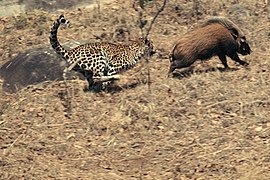Leopard
| Leopard Temporal range:
| |
|---|---|
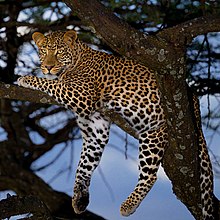
| |
| Male Maasai Mara National Reserve, Kenya
| |
| Scientific classification | |
| Domain: | Eukaryota |
| Kingdom: | Animalia |
| Phylum: | Chordata |
| Class: | Mammalia |
| Order: | Carnivora |
| Suborder: | Feliformia |
| Family: | Felidae |
| Subfamily: | Pantherinae |
| Genus: | Panthera |
| Species: | P. pardus[1]
|
| Binomial name | |
| Panthera pardus[1] | |
| Subspecies | |
|
See text | |
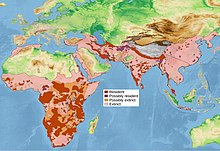
| |
| Present and historical distribution of the leopard[2] | |
The leopard (Panthera pardus) is one of the five extant
. Its body is slender and muscular reaching a length of 92–183 cm (36–72 in) with a 66–102 cm (26–40 in) long tail and a shoulder height of 60–70 cm (24–28 in). Males typically weigh 30.9–72 kg (68–159 lb), and females 20.5–43 kg (45–95 lb).The leopard was first
The leopard is adapted to a variety of habitats ranging from
Listed as
Etymology
The English name "leopard" comes from Old French leupart or Middle French liepart, that derives from Latin leopardus and ancient Greek λέοπάρδος (leopardos). Leopardos could be a compound of λέων (leōn), meaning 'lion', and πάρδος (pardos), meaning 'spotted'.[3][4][5] The word λέοπάρδος originally referred to a cheetah (Acinonyx jubatus).[6]
"Panther" is another common name, derived from Latin panther and ancient Greek πάνθηρ (pánthēr);
Taxonomy

Felis pardus was the
The leopard was designated as the type species of Panthera by Joel Asaph Allen in 1902.[12] In 1917, Reginald Innes Pocock also subordinated the tiger (P. tigris), lion (P. leo), and jaguar (P. onca) to Panthera.[13][14]
Living subspecies
Following Linnaeus' first description, 27 leopard
In 2017, the Cat Classification Task Force of the Cat Specialist Group recognized the following eight subspecies as valid taxa:[17]
| Subspecies | Distribution | Image |
|---|---|---|
| African leopard (P. p. pardus) (Linnaeus, 1758)[1] | It is the most widespread leopard subspecies and is native to most of Sub-Saharan Africa.[2] | 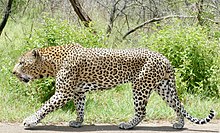
|
| Indian leopard (P. p. fusca) (Meyer, 1794)[18] | It occurs in the Indian subcontinent, Myanmar and southern Tibet.[17][19] It is listed as Near Threatened.[20] | 
|
| Javan leopard (P. p. melas) (Cuvier, 1809)[21] | It is native to Java in Indonesia and has been assessed as Endangered in 2021.[22] | 
|
| Arabian leopard (P. p. nimr) (Hemprich and Ehrenberg, 1830)[23] | It is the smallest leopard subspecies and considered endemic to the Arabian Peninsula.[24] As of 2023, the population was estimated to comprise 100–120 individuals in Oman and Yemen; it was therefore assessed as Critically Endangered in 2023.[25] | 
|
| P. p. tulliana (Valenciennes, 1856)[26] | It occurs from eastern Endangered.[27]
The Balochistan leopard population in the south of Iran, Afghanistan and Pakistan is separated from the northern population by the Dasht-e Kavir and Dasht-e Lut deserts.[28] |

|
| Amur leopard (P. p. orientalis) (Schlegel, 1857)[29][30] | It is native to the Korean peninsula.[2]
|

|
| Indochinese leopard (P. p. delacouri) Pocock, 1930[31] | It occurs in mainland Southeast Asia and southern China, and is listed as Critically Endangered.[32]
|
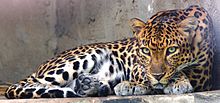
|
| Sri Lankan leopard (P. p. kotiya) Deraniyagala, 1956[33] | It is native to Sri Lanka and listed as Vulnerable.[34] | 
|
Results of an analysis of molecular variance and pairwise fixation index of 182 African leopard museum specimens showed that some African leopards exhibit higher genetic differences than Asian leopard subspecies.[35]
Evolution

Results of
Results of a phylogenetic analysis of chemical secretions amongst cats indicated that the leopard is closely related to the lion.[40] The geographic origin of the Panthera is most likely northern Central Asia. The leopard-lion clade was distributed in the Asian and African
The oldest unambiguous fossils of the leopard are from Eastern Africa, dating to around 2 million years ago.[43]
Leopard-like fossil bones and teeth possibly dating to the
Leopards depicted in cave paintings in Chauvet Cave provide indirect evidence of leopard presence in Europe.[46] Leopard fossils dating to the Late Pleistocene were found in Biśnik Cave in south-central Poland.[48][45] Fossil remains were also excavated in the Iberian[49][50] and Italian Peninsula,[51] and in the Balkans.[52][53] Leopard fossils dating to the Pleistocene were also excavated in the Japanese archipelago.[54] Leopard fossils were also found in Taiwan.[55]
Hybrids
In 1953, a male leopard and a female lion were
Characteristics
The leopard's fur is generally soft and thick, notably softer on the belly than on the back.
Its white-tipped tail is about 60–100 cm (23.6–39.4 in) long, white underneath and with spots that form incomplete bands toward the end of the tail.[64] The guard hairs protecting the basal hairs are short, 3–4 mm (0.1–0.2 in) in face and head, and increase in length toward the flanks and the belly to about 25–30 mm (1.0–1.2 in). Juveniles have woolly fur that appear to be dark-coloured due to the densely arranged spots.[61][65] Its fur tends to grow longer in colder climates.[66] The leopard's rosettes differ from those of the
Melanistic leopards are also known as
In India, nine pale and white leopards were reported between 1905 and 1967.[72] Leopards exhibiting erythrism were recorded between 1990 and 2015 in South Africa's Madikwe Game Reserve and in Mpumalanga. The cause of this morph known as a "strawberry leopard" or "pink panther" is not well understood.[73]Size
The leopard is a slender and muscular cat, with relatively short limbs and a broad head. It is
The largest recorded skull of a leopard was found in India in 1920 and measured 28 cm (11 in) in
Distribution and habitat
The leopard has the largest distribution of all wild cats, occurring widely in Africa, the Caucasus and Asia, although populations are fragmented and declining. It is considered to be locally extinct in North Africa.[2] It inhabits foremost savanna and rainforest, and areas where grasslands, woodlands, and riverine forests remain largely undisturbed.[60] In sub-Saharan Africa, it is still numerous and surviving in marginal habitats where other large cats have disappeared. There is considerable potential for human-leopard conflict due to leopards preying on livestock.[80]
Leopard populations in the Arabian Peninsula are small and fragmented.[81][82][83] In southeastern Egypt, a leopard killed in 2017 was the first sighting of the species in this area in 65 years.[84]
In the
In Nepal's
In Myanmar, leopards were recorded for the first time by camera traps in the hill forests of Myanmar'sIn Java, leopards inhabit dense
In the Russian Far East, it inhabits temperate coniferous forests where winter temperatures reach a low of −25 °C (−13 °F).[16]
Behaviour and ecology
The leopard is a solitary and
The whitish spots on the back of its ears are thought to play a role in communication.[99] It has been hypothesized that the white tips of their tails may function as a 'follow-me' signal in
Leopards are mainly active from dusk till dawn and will rest for most of the day and some hours at night in thickets, among rocks or over tree branches. Leopards have been observed walking 1–25 km (0.62–15.53 mi) across their range at night; wandering up to 75 km (47 mi) if disturbed.[65][75] In some regions, they are nocturnal.[102][103] In western African forests, they have been observed to be largely diurnal and hunting during twilight, when their prey animals are active; activity patterns vary between seasons.[104]
Leopards can climb trees quite skillfully, often resting on tree branches and descending headfirst.[60] They can run at over 58 km/h (36 mph; 16 m/s), leap over 6 m (20 ft) horizontally, and jump up to 3 m (9.8 ft) vertically.[98]
-
A female leopard with white markings on the backs of her ears.
-
A female leopard showing white spots on the tail
-
A leopard climbing down a tree
-
A leopard hunting a bushpig
-
Video of a leopard in the wild
Social spacing
In Kruger National Park, most leopards tend to keep 1 km (0.62 mi) apart.[106] Males occasionally interact with their partners and cubs, and exceptionally this can extend beyond to two generations.[74][107] Aggressive encounters are rare, typically limited to defending territories from intruders.[66] In a South African reserve, a male was wounded in a male–male territorial battle over a carcass.[102]
Males occupy home ranges that often overlap with a few smaller female home ranges, probably as a strategy to enhance access to females. In the Ivory Coast, the home range of a female was completely enclosed within a male's.[108] Females live with their cubs in home ranges that overlap extensively, probably due to the association between mothers and their offspring. There may be a few other fluctuating home ranges belonging to young individuals. It is not clear if male home ranges overlap as much as those of females do. Individuals try to drive away intruders of the same sex.[65][75]
A study of leopards in the Namibian farmlands showed that the size of home ranges was not significantly affected by sex, rainfall patterns or season; the higher the prey availability in an area, the greater the leopard population density and the smaller the size of home ranges, but they tend to expand if there is human interference.[109] Sizes of home ranges vary geographically and depending on habitat and availability of prey. In the
Hunting and diet
The leopard is a
The largest prey killed by a leopard was reportedly a male eland weighing 900 kg (2,000 lb).[98] A study in Wolong National Nature Reserve in southern China demonstrated variation in the leopard's diet over time; over the course of seven years, the vegetative cover receded, and leopards opportunistically shifted from primarily consuming tufted deer to pursuing bamboo rats and other smaller prey.[115]
The leopard depends mainly on its acute senses of hearing and vision for hunting.[116] It primarily hunts at night in most areas.[65] In western African forests and Tsavo National Park, they have also been observed hunting by day.[117] They usually hunt on the ground. In the Serengeti, they have been seen to ambush prey by descending on it from trees.[118]
It stalks its prey and tries to approach as closely as possible, typically within 5 m (16 ft) of the target, and, finally, pounces on it and kills it by suffocation. It kills small prey with a bite to the back of the neck, but holds larger animals by the throat and strangles them.[65] It caches kills up to 2 km (1.2 mi) apart.[74] It is able to take large prey due to its powerful jaw muscles, and is therefore strong enough to drag carcasses heavier than itself up into trees; an individual was seen to haul a young giraffe weighing nearly 125 kg (276 lb) up 5.7 m (18 ft 8 in) into a tree.[117] It eats small prey immediately, but drags larger carcasses over several hundred meters and caches it safely in trees, bushes or even caves; this behaviour allows the leopard to store its prey away from rivals, and offers it an advantage over them. The way it stores the kill depends on local topography and individual preferences, varying from trees in Kruger National Park to bushes in the plain terrain of the Kalahari.[66][119]
Average daily consumption rates of 3.5 kg (7 lb 11 oz) were estimated for males and of 2.8 kg (6 lb 3 oz) for females.
Enemies and competitors

In parts of its range, the leopard is
While interspecies killing of full-grown leopards is generally rare, given the opportunity, both the tiger and lion readily kill and consume both young and adult leopards.[118][121][124][125] In the Kalahari Desert, leopards frequently lose kills to brown hyenas, if they are unable to move the kill up a tree. Single brown hyenas have been observed charging at and displacing male leopards from kills.[126][127] Lions occasionally fetch leopard kills from trees.[119]
Nile crocodiles occasionally prey on leopards. In one occasion, a large adult leopard was grabbed and consumed by a large crocodile while attempting to hunt along a river bank in Kruger National Park.[106][74] Mugger crocodiles reportedly killed an adult leopard in Rajasthan.[131] An adult leopard was recovered from the stomach of a 5.5 m (18 ft 1 in) Burmese python (Python bivittatus).[132] In the Serengeti National Park, troops of around 30–40 olive baboons were observed mobbing and attacking a female leopard and her cubs.[133]
Reproduction and life cycle
In some areas, leopards mate all year round. In Manchuria and Siberia, they mate during January and February. On average, females begin to breed between the ages of 2½ and three, and males between the ages of two and three.[60] The female's estrous cycle lasts about 46 days, and she is usually in heat for 6–7 days.[134] Gestation lasts for 90 to 105 days.[135] Cubs are usually born in a litter of 2–4 cubs.[136] The mortality rate of cubs is estimated at 41–50% during the first year.[106] Lions and spotted hyenas are the biggest cause for leopard cub mortality during their first year. Male leopards are known to cause infanticide, in order to bring the female back into heat.[74] Intervals between births average 15 to 24 months, but can be shorter, depending on the survival of the cubs.[60]
Females give birth in a cave, crevice among boulders, hollow tree or thicket. Newborn cubs weigh 280–1,000 g (9.9–35.3 oz), and are born with closed eyes, which open four to nine days after birth.[98][66] The fur of the young tends to be longer and thicker than that of adults. Their pelage is also more gray in colour with less defined spots. They begin to eat meat at around nine weeks.[74] Around three months of age, the young begin to follow the mother on hunts. At one year of age, cubs can probably fend for themselves, but will remain with the mother for 18–24 months.[137] After separating from their mother, sibling cubs may travel together for months.[60] Both male and female leopards typically reach sexual maturity at 2–2⅓ years.[74]
The generation length of the leopard is 9.3 years.[138] The average life span of a leopard is 12–17 years.[98] The oldest leopard was a captive female that died at the age of 24 years, 2 months and 13 days.[139]
Conservation
The leopard is listed on
Threats
The leopard is primarily threatened by habitat fragmentation and conversion of forest to agriculturally used land, which lead to a declining natural prey base, human–wildlife conflict with livestock herders and high leopard mortality rates. It is also threatened by trophy hunting and poaching.[2] Contemporary records suggest that the leopard occurs in only 25% of its historical range.[141][142]
Between 2002 and 2012, at least four leopards were estimated to have been poached per week in India for the
Surveys in the Central African Republic's
In Java, the leopard is threatened by illegal hunting and trade. Between 2011 and 2019, body parts of 51 Javan leopards were seized including six live individuals, 12 skins, 13 skulls, 20 canines and 22 claws.[147]
Human relations
Cultural significance
Leopards have been featured in art, mythology and folklore of many countries. In
In Rudyard Kipling's "How the Leopard Got His Spots", one of his Just So Stories, a leopard with no spots in the Highveld lives with his hunting partner, the Ethiopian. When they set off to the forest, the Ethiopian changed his brown skin, and the leopard painted spots on his skin.[151] A leopard played an important role in the 1938 Hollywood film Bringing Up Baby. African chiefs, European queens, Hollywood actors and burlesque dancers wore coats made of leopard skins.[148]
The leopard is a frequently used motif in
Attacks on people
The Leopard of Rudraprayag killed more than 125 people; the Panar Leopard was thought to have killed over 400 people. Both were shot by British hunter Jim Corbett.[154] The spotted devil of Gummalapur killed about 42 people in Karnataka, India.[155]
In captivity

The
See also
References
- ^ OCLC 62265494.
- ^ . Retrieved 16 January 2024.
- ^ a b Lewis, C. T. & Short, C. (1879). "lěǒpardus". A Latin Dictionary. Oxford: Clarendon Press. p. 1069.
- ^ Liddell, H. G. & Scott, R. (1889). "λέο-πάρδος". A Greek–English Lexicon. Oxford: Clarendon Press. p. 884.
- ISBN 978-0-517-41425-5.
- S2CID 56160515.
- ^ Lewis, C. T. & Short, C. (1879). "panthera". A Latin Dictionary. Oxford: Clarendon Press. p. 1298.
- ^ Lewis, C. T. & Short, C. (1879). "pardus". A Latin Dictionary. Oxford: Clarendon Press. p. 1302.
- ^ Linnaeus, C. (1758). "Felis pardus". Caroli Linnæi Systema naturæ per regna tria naturæ, secundum classes, ordines, genera, species, cum characteribus, differentiis, synonymis, locis. Vol. Tomus I (decima, reformata ed.). Holmiae: Laurentius Salvius. pp. 41−42. (in Latin)
- ^ Oken, L. (1816). "1. Art, Panthera". Lehrbuch der Zoologie. 2. Abtheilung. Jena: August Schmid & Comp. p. 1052.
- ^ Ellerman, J. R.; Morrison-Scott, T. C. S. (1966). Checklist of Palaearctic and Indian mammals 1758 to 1946 (Second ed.). London: British Museum of Natural History. pp. 315–317.
- ^ Allen, J. A. (1902). "Mammal names proposed by Oken in his 'Lehrbuch der Zoologie'". Bulletin of the American Museum of Natural History. 16 (27): 373−379.
- .
- ^ Pocock, R. I. (1939). "Panthera pardus". The Fauna of British India, including Ceylon and Burma. Mammalia: Volume 1. London: Taylor and Francis. pp. 222–239.
- .
- ^ (PDF) from the original on 2011-09-10.
- ^ a b Kitchener, A. C.; Breitenmoser-Würsten, C.; Eizirik, E.; Gentry, A.; Werdelin, L.; Wilting, A.; Yamaguchi, N.; Abramov, A. V.; Christiansen, P.; Driscoll, C.; Duckworth, J. W.; Johnson, W.; Luo, S.-J.; Meijaard, E.; O’Donoghue, P.; Sanderson, J.; Seymour, K.; Bruford, M.; Groves, C.; Hoffmann, M.; Nowell, K.; Timmons, Z. & Tobe, S. (2017). "A revised taxonomy of the Felidae: The final report of the Cat Classification Task Force of the IUCN Cat Specialist Group" (PDF). Cat News (Special Issue 11): 73–75.
- ^ Meyer, F. A. A. (1794). "Über de la Metheries schwarzen Panther". Zoologische Annalen. Erster Band. Weimar: Im Verlage des Industrie-Comptoirs. pp. 394–396.
- .
- ^ Shivakumar, S.; Khettry, A.; Surve, N.; Rahman, H.; Ghimirey, Y.; Tharchen, L.; Zaw, T.; Waseem, M. & Jhala, Y. (2023). "Panthera pardus ssp. fusca". IUCN Red List of Threatened Species. 2023: e.T215195524A215195533. Retrieved 17 March 2024.
- ^ Cuvier, G. (1809). "Recherches sur les espėces vivantes de grands chats, pour servir de preuves et d'éclaircissement au chapitre sur les carnassiers fossils". Annales du Muséum National d'Histoire Naturelle. Tome XIV: 136–164.
- . Retrieved 11 November 2023.
- ^ Hemprich, W.; Ehrenberg, C. G. (1830). "Felis, pardus?, nimr". In Dr. C. G. Ehrenberg (ed.). Symbolae Physicae, seu Icones et Descriptiones Mammalium quae ex Itinere per Africam Borealem et Asiam Occidentalem Friderici Guilelmi Hemprich et Christiani Godofredi Ehrenberg. Decas Secunda. Zoologica I. Mammalia II. Berolini: Officina Academica. pp. Plate 17.
- ^ Spalton, J. A. & Al Hikmani, H. M. (2006). "The Leopard in the Arabian Peninsula – Distribution and subspecies status" (PDF). Cat News (Special Issue 1): 4–8. Archived (PDF) from the original on 2015-06-19.
- ^ Al Hikmani, H.; Spalton, A.; Zafar-ul Islam, M.; al-Johany, A.; Sulayem, M.; Al-Duais, M. & Almalki, A. (2023). "Panthera pardus ssp. nimr". IUCN Red List of Threatened Species. 2023: e.T15958A46767457. Retrieved 17 March 2024.
- ^ Valenciennes, A. (1856). "Sur une nouvelles espèce de Panthère tué par M. Tchihatcheff à Ninfi, village situé à huit lieues est de Smyrne". Comptes Rendus Hebdomadaires des Séances de l'Académie des Sciences. 42: 1035–1039.
- . Retrieved 17 March 2024.
- .
- ^ Schlegel, H. (1857). "Felis orientalis". Handleiding Tot de Beoefening der Dierkunde, Ie Deel. Breda: Boekdrukkerij van Nys. p. 23.
- .
- ^ Pocock, R. I. (1930). "The Panthers and Ounces of Asia". Journal of the Bombay Natural History Society. 34 (2): 307–336.
- ^ Rostro-García, S.; Kamler, J.F.; Clements, G.R.; Lynam, A.J. & Naing, H. (2019). "Panthera pardus ssp. delacouri". IUCN Red List of Threatened Species. 2019: e.T124159083A163986056. Retrieved 17 March 2024.
- ^ Deraniyagala, P. E. P. (1956). "The Ceylon leopard, a distinct subspecies". Spolia Zeylanica. 28: 115–116.
- ^ Kittle, A.M. & Watson, A. (2020). "Panthera pardus ssp.kotiya". IUCN Red List of Threatened Species. 2020: e.T15959A50660847. Retrieved 17 March 2024.
- S2CID 4348541.
- ^ S2CID 41672825.
- ^ ISBN 978-0-19-923445-5.
- ^ PMID 20138224. Archived from the original(PDF) on 2016-03-05.
- ^ PMID 22016768.
- .
- PMID 24225466.
- PMID 26518481.
- ^ PMID 30348080.
- ^ Schmid, E. (1940). "Variationstatistische Untersuchungen am Gebiss pleistozäner und rezenter Leoparden und anderer Feliden". Zeitschrift für Säugetierkunde. 15: 1–179.
- ^ S2CID 255850069.
- ^ .
- .
- .
- .
- S2CID 134157124.
- .
- .
- .
- ISBN 978-4-87974-691-7.
- PMID 34513335.
- ISBN 978-0-8493-2100-9.
- ISBN 9780521844185.
- ^ a b Mivart, St. G. J. (1900). "Different kind of Cats". The Cat: An Introduction to the Study of Backboned Animals, Especially Mammals. London: John Murray. pp. 391–439.
- .
- ^ a b c d e f g h Nowell, K. & Jackson, P. (1996). "Leopard Panthera pardus (Linnaeus, 1758)". Wild Cats: status survey and conservation action plan. Gland, Switzerland: IUCN/SSC Cat Specialist Group. Archived from the original on 2014-02-22.
- ^ ISBN 978-1-86872-594-6.
- ISBN 978-93-5009-761-8.
- PMID 20961899.
- ^ ISBN 978-977-416-254-1.
- ^ ISBN 978-0-520-08085-0.
- ^ S2CID 44839740.
- ISBN 978-90-04-08876-4.
- S2CID 5446868.
- S2CID 19021807.
- .
- PMID 28379961.
- ^ Divyabhanusinh (1993). "On mutant leopards Panthera pardus from India". Journal of the Bombay Natural History Society. 90 (1): 88−89.
- .
- ^ ISBN 978-1-4081-8996-2.
- ^ ISBN 978-0-8018-5789-8.
- ISBN 978-0-7894-7764-4.
- ^ "Is this the longest leopard in India?". The Times of India. 2016.
- ^ "Leopard shot in Bilaspur turns out to be a record breaker". The Tribune Trust. 2016.
- ^ Prater, S. H. (1921). "Record Panther Skull (P. p. pardus)". The Journal of the Bombay Natural History Society. XXVII (Part IV): 933–935.
- PMID 28584709.
- ^ Spalton, J. A. & Al Hikmani, H. M. (2006). "The Leopard in the Arabian Peninsula – Distribution and Subspecies Status" (PDF). Cat News (Special Issue 1): 4–8. Archived (PDF) from the original on 2011-05-23.
- ^ Judas, J.; Paillat, P.; Khoja, A. & Boug, A. (2006). "Status of the Arabian leopard in Saudi Arabia" (PDF). Cat News (Special Issue 1): 11–19. Archived (PDF) from the original on 2015-09-19.
- ^ Al Jumaily, M.; Mallon, D. P.; Nasher, A. K. & Thowabeh, N. (2006). "Status Report on Arabian Leopard in Yemen". Cat News (Special Issue 1): 20–25.
- S2CID 90676105.
- ^ Jhala, Y.V.; Qureshi, Q. & Yadav, S.P. (2020). Status of leopards in India, 2018. Technical Report TR/2020/16 (Report). New Delhi and Dehradun: National Tiger Conservation Authority, Government of India and Wildlife Institute of India.
- ^ Arthreya, V. (2012). "Living with Leopards Outside Protected Areas in India". Conservation India.
- ^ Thapa, K.; Pradhan, N. M. B.; Berker, J.; Dhakal, M.; Bhandari, A. R.; Gurung, G. S.; Rai, D. P.; Thapa, G. J.; Shrestha, S. & Singh, G. R. (2013). "High elevation record of a leopard cat in the Kangchenjunga Conservation Area, Nepal". Cat News (58): 26–27.
- ^ Kittle, A. M.; Watson, A. C.; Chanaka Kumara, P. H. & Nimalka Sanjeewani, H. K. (2014). "Status and distribution of the leopard in the central hills of Sri Lanka". Cat News (56): 28−31.
- .
- .
- hdl:10722/232870.
- (PDF) from the original on 2017-08-10.
- ^ Robichaud, W.; Insua-Cao; Sisomphane, P. C. & Chounnavanh, S. (2010). "Appendix 4". A scoping mission to Nam Kan National Protected Area, Lao PDR. Fauna & Flora International. pp. 33−42.
- ^ Gray, T. N. & Phan, C. (2011). "Habitat preferences and activity patterns of the larger mammal community in Phnom Prich Wildlife Sanctuary, Cambodia". The Raffles Bulletin of Zoology. 59 (2): 311−318.
- ^ Gray, T. N. E. (2013). "Activity patterns and home ranges of Indochinese leopard Panthera pardus delacouri in the Eastern Plains Landscape, Cambodia" (PDF). Natural History Bulletin of the Siam Society. 59: 39−47. Archived (PDF) from the original on 2016-02-22.
- ^ Li, S.; Wang, D.; Lu, Z. & Mc Shea, W. J. (2010). "Cats living with pandas: The status of wild felids within giant panda range, China". Cat News. 52: 20–23.
- PMID 29949588.
- ^ ISBN 978-0-226-77999-7.
- ISBN 9780824070175.
- .
- .
- ^ a b Hunter, L.; Balme, G.; Walker, C.; Pretorius, K. & Rosenberg, K. (2003). "The landscape ecology of leopards (Panthera pardus) in northern KwaZulu-Natal, South Africa: a preliminary project report" (PDF). Ecological Journal. 5: 24–30. Archived from the original (PDF) on March 4, 2009.

- .
- .
- ISBN 978-3-662-03766-9.
- ^ ISBN 978-1-932846-11-9.
- .
- .
- ^ Marker, L. L. & Dickman, A. J. (2005). "Factors affecting leopard (Panthera pardus) spatial ecology, with particular reference to Namibian farmlands" (PDF). South African Journal of Wildlife Research. 35 (2): 105–115.

- ^ Bertram, B. C. R. (1982). "Leopard ecology as studied by radio tracking". Symposia of the Zoological Society of London. 49: 341–352.
- .
- .
- S2CID 86140708.
- (PDF) from the original on 2012-11-05.
- JSTOR 1382285.
- ISBN 978-0-947430-55-9.
- ^ a b Hamilton, P. H. (1976). The movements of leopards in Tsavo National Park, Kenya, as determined by radio-tracking (M.Sc. thesis). Nairobi: University of Nairobi.
- ^ S2CID 84619500.
- ^ ISBN 978-0-394-47242-3.
- ^ Bothma, J. du P. (2005). "Water-use by southern Kalahari leopards" (PDF). South African Journal of Wildlife Research. 35: 131–137.

- ^ S2CID 4343007. Archived from the original(PDF) on 2019-09-29.
- ^ Kurt, F. & Jayasuriya, A. (1968). "Notes on a dead bear". Loris (11): 182–183.
- ^ Baskaran, N.; Sivaganesan, N. & Krishnamoorthy, J. (1997). "Food habits of sloth bear in Mudumalai Wildlife Sanctuary, Tamil Nadu, southern India". Journal of the Bombay Natural History Society. 94: 1–9.
- ^ JSTOR 2989714.
- S2CID 84997827.
- ^ Owens, D. & Owens, M. (1980). "Hyenas of the Kalahari". Natural History. 89 (2): 50.
- ISBN 978-0-395-32214-7.
- .
- .
- PMID 30010193.
- ^ Bhatnagar, C.; Mahur, M. (2010). "Observations on feeding behavior of a wild population of marsh crocodile in Baghdarrah Lake, Udaipur, Rajasthan". Reptile Rap. 10: 16–18.
- ISBN 978-1-55407-802-8.
- .
- .
- ^ Hemmer, H. (1976). "Gestation period and postnatal development in felids". In Eaton, R.L. (ed.). The World's Cats. Vol. 3. Carnivore Research Institute, Univ. Washington, Seattle. pp. 143–165.
- ^ Eaton, R.L. (1977). "Reproductive biology of the leopard". Zoologischer Garten. 47 (5): 329–351.
- ^ "Leopard (Panthera pardus); Physical characteristics and distribution". Comparative Mammalian Brain Collections.
- ^ Pacifici, M.; Santini, L.; Di Marco, M.; Baisero, D.; Francucci, L.; Grottolo Marasini, G.; Visconti, P. & Rondinini, C. (2013). "Generation length for mammals". Nature Conservation (5): 87–94.
- ^ Salisbury, S. (2014). "Roxanne, oldest spotted leopard in captivity, dies at Acreage preserve". The Palm Beach Post. Archived from the original on 2014-08-11.
- ^ Rozhnov, V.V.; Yachmennikova, A.A.; Dronova, N.A.; Naidenko, S.V.; Hernandez-Blanco, J.A.; Chistopolova, M.D.; Pkhitikov, A.B.; Tembotova, F.A.; Trepet, S.A. & Chestin, I.E. (2022). "Experience of the leopard re-covering through reintroduction in the Russian Caucasus" (PDF). Cat News (Special issue): 67–71.
- PMID 27168983.
- PMID 28484625.
- ^ Raza, R.H.; Chauhan, D.S.; Pasha, M.K.S. & Sinha, S. (2012). Illuminating the blind spot: A study on illegal trade in Leopard parts in India (2001–2010) (PDF) (Report). New Delhi: TRAFFIC India, WWF India. Archived (PDF) from the original on 2020-09-24.
- ^ Bergin, D. & Nijman, V. (2014). "Open, Unregulated Trade in Wildlife in Morocco's Markets". TRAFFIC Bulletin. 26 (1): 65–70.
- S2CID 34533018.
- (PDF) from the original on 2020-10-03.
- S2CID 233286106.
- ^ ISBN 9781780233185.
- (PDF) from the original on 2006-09-14.
- ^ a b "Benin: an African kingdom" (PDF). London: British Museum. Archived (PDF) from the original on 2008-08-05. Retrieved 2016-03-29.
- ^ Kipling, R. (1902). "How the Leopard Got His Spots" (PDF). Just So Stories. Macmillan.
- ISBN 978-0-8153-2952-7.
- ^ Pedersen, C. F. (1971). The International Flag Book in Color. Morrow.
- ^ Corbett, J. (1955). The Temple Tiger, and More Man-eaters of Kumaon. Oxford: Oxford University Press.
- ^ Anderson, K. (1954). "The Spotted Devil of Gummalapur". Nine Man-Eaters and one Rogue. London: George Allen & Unwin. pp. 36–51.
- ^ Owen, J. (2005). "Medieval Lion Skulls Reveal Secrets of Tower of London 'Zoo'". National Geographic Magazine. Archived from the original on November 5, 2005. Retrieved 2007-09-05.
Further reading
- ISBN 978-0-8248-2884-4.
- DeRuiter, D. J.; .
- Schaller, G. B. (1972). The Serengeti Lion. Chicago: University of Chicago Press. ISBN 978-0-226-73639-6.
- Sanei, A. (2007). Analysis of leopard (Panthera pardus) status in Iran (in Persian). Tehran: Sepehr Publication Center. ISBN 978-964-6123-74-8.
- Sanei, A.; Zakaria, M.; Yusof, E.; Roslan, M. (2011). "Estimation of leopard population size in a secondary forest within Malaysia's capital agglomeration using unsupervised classification of pugmarks" (PDF). Tropical Ecology. 52 (1): 209–217. Archived (PDF) from the original on 2011-10-02.
- Taylor, P.; Barrientos, S.; Dolan, C. (2005). Beyond Conservation: A Wildland Strategy. Earthscan. ISBN 978-1-84407-197-5.
- Zakaria, M.; Sanei, A. (2011). "Conservation and management prospects of the Persian and Malayan leopards". Asia Life Sciences. Supplement 7: 1–5.
External links
- IUCN/SSC Cat Specialist Group: Panthera pardus in Africa and Panthera pardus in Asia
- . Encyclopædia Britannica (11th ed.). 1911.










